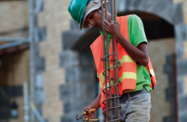Increased investment in low-cost housing, improved access to home loans and streamlined procedures for building applications should feed into a stronger performance from Trinidad and Tobago’s construction sector in the near term. However, delays in payments for work completed, plus lengthy bureaucratic procedures, continue to pose challenges to expediting construction works.

With the economy in recession since 2015 and capital expenditure falling TT$2bn ($296.4m) short of the TT$7bn ($1bn) allocated in last year’s budget, the construction industry had a difficult year in 2016, posting a 7.6% reduction in activity, according to Ministry of Finance data.
Affordable housing boost
The residential component of the sector, however, could rebound from the lows of last year under government plans to accelerate the development of low-cost housing programmes.
In early February, Randall Mitchell, minister of housing and urban development, announced that work would begin this year on 2500 residential units – a project that the ministry expects will provide opportunities for local housing contractors, as well as infrastructure providers and suppliers.
While the new residential units will help ease the housing shortfall somewhat, some estimates put the number of applicants on the waiting list for affordable housing at 120,000, leaving a sizeable deficit.
To further narrow this gap, Mitchell also announced reforms to the state mortgage financing scheme, measures that should allow more citizens to obtain loans for housing and stimulate growth in the construction sector.
Under the changes, the monthly income ceiling to qualify for a loan from T&T Mortgage Finance at the lowest 2% rate has been lifted from TT$10,000 ($1475) to TT$14,000 ($2066), while the maximum value of a property for a loan at this rate was raised from TT$850,000 ($126,000) to $1.2m ($178,000).
To obtain financing at the higher 5% rate, the income bar has been moved from TT$14,001 ($2066) to TT$30,000 ($4430) a month, with the limit on property value raised from TT$1.2m ($177,150) to TT$1.5m ($221,440).
These changes should give far more people access to the housing market, and in turn boost demand for the construction of new units.
Payment flow concern
While the sector will welcome new projects to the housing development pipeline, some state agencies might experience strain on capacity amid extended delays in payments for completed construction work.
In the fourth quarter of last year, the government paid out TT$530m ($78.2m) to cover some of its outstanding debt to contractors. Despite this outlay, the total remains at TT$1.9bn ($280.4m), according to a recent statement from the Trinidad and Tobago Contractors’ Association, a body that represents a number of firms in the building industry.
This may make some constructors wary about committing to new projects until further progress is made in clearing the backlog.
Expediting delivery
Convoluted bureaucratic procedures that extend project delivery times are also seen as an obstacle to sector growth.
In its “Doing Business 2017” report, the World Bank found it takes 253 working days to complete the 16 procedures required to build a standardised warehouse in T&T, ranking it 149th of 190 countries under the “dealing with construction permits” metric.
By comparison, the average time needed in the Caribbean and Latin America region was 181.1 days, with the gap between T&T and high-income OECD countries even wider at 152.1 days.
Such a disparity, especially at the regional level, could put T&T at a disadvantage in the eyes of investors, for whom time is a critical factor when considering launching or expanding operations.
In a move to address this problem, the Ministry of Planning and Development announced in mid-February that it would be moving the building application process online.
The ministry said that the digitalisation of the process would lead to improvements in efficiency, ease the logistical burden for applicants and strengthen management oversight, transparency and customer service delivery.
Among the features of the automated system will be online registration and submission of applications, e-mail notifications, web monitoring of the progress of applications and electronic payment methods.
While the planned reforms should help address a key weakness in T&T’s construction development chain, a timeline for their implementation has not yet been made clear.


